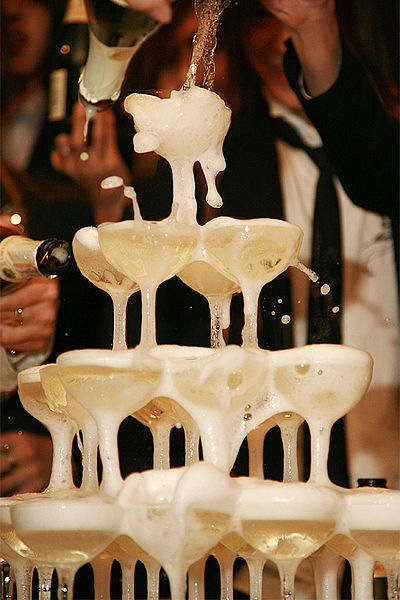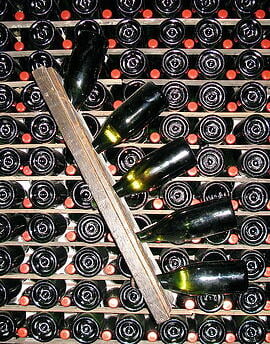 Sparkling Wines
Sparkling Wines
Want to piss off a wine professional? Call a sparkling wine Champagne. Not all bubbles are created equal, and to call any old sparkling wine Champagne is like calling your grandfather's hand-me-down jalopy a Lamborghini. So let's get down to business. Pull up a glass and pay attention - this is serious business ;)
How do we get bubbles?
Quality sparkling wines get their fizz from a secondary fermentation, brought about by yeats that jumpstart the process.
Methods of Production
- Injection: This the cheapest and easiest way to make saparkling wine...and it shows! Take table wine, CO2, cork and voila! You have Andre. Do not waste your money on this nonsense
- Tank: Also known as the Charmat method, which creates delightfully charming wines like Prosecco. The secondary fermentation occurs in pressurized tank, and the wine is drained off and bottled without spending a lot of time on the yeasts (also called lees) The result is wines that fresh, light, posessing soft, fat almost squishy bubles on the palate. Plus since the method of production is quick and not too labor intensive, these wines tend to be easy on the wallet, too.
- Transfer: The transfer method is slightly more complicated than tank, but still relatively budget friendly. The secondary fermentation take splace in the bottle, but then the contents are poured back into a tank where the yeasts are filtered out. This method is somewhat uncommon, but sparkling Shiraz is one type of wine that relies on this method for its bubble.
- Methode Traditionelle: When this method is employed in the production of sparkling wines from Champagne France, then yes, we can call it Champagne. Other types of wines that use this
 method are Cava and Franciacorta and French Cremants. The process is long and involved: The secondary fermentation occurs in the bottle, where it ages on its yeasts for a minimum of 15 months. So how the heck do we get those yeasts out? Through a process known as riddling or remuage, which through a series of twisting and angling the bottles slowly works the yeast gentle down,until it collects at the neck of the bottle. In Champagne this process is done by hand (see right) and takes 6 weeks.In Cava, this process is done by a machine called a Gyropallette and takes 6 days (ergo Cava's sweet, sweet price tag). Once the yeast has made it to the top of the bottle, it is popped out, and varying levels of sugar are added before the final product is capped with the tell tale mushroom cork.
method are Cava and Franciacorta and French Cremants. The process is long and involved: The secondary fermentation occurs in the bottle, where it ages on its yeasts for a minimum of 15 months. So how the heck do we get those yeasts out? Through a process known as riddling or remuage, which through a series of twisting and angling the bottles slowly works the yeast gentle down,until it collects at the neck of the bottle. In Champagne this process is done by hand (see right) and takes 6 weeks.In Cava, this process is done by a machine called a Gyropallette and takes 6 days (ergo Cava's sweet, sweet price tag). Once the yeast has made it to the top of the bottle, it is popped out, and varying levels of sugar are added before the final product is capped with the tell tale mushroom cork.
Grapes
- Champagne: Pinot Noir, Pinot Meunier and Chardonnay
- Prosecco: Prosecco
- Cava: Macabeo, Xarello and Paralleda
- Franciacorta: Chardonnay, Pinot Bianco (AKA Pinot Blanc) and Pinot Nero (AKA Pinot Noir).
- Lambrusco: Lambrusco
- Sekt: Riesling,. Pinot Blanc, Pinot Gris and Pinot Noir
 Sparkling Wines
Sparkling Wines method are Cava and Franciacorta and French Cremants. The process is long and involved: The secondary fermentation occurs in the bottle, where it ages on its yeasts for a minimum of 15 months. So how the heck do we get those yeasts out? Through a process known as riddling or remuage, which through a series of twisting and angling the bottles slowly works the yeast gentle down,until it collects at the neck of the bottle. In Champagne this process is done by hand (see right) and takes 6 weeks.In Cava, this process is done by a machine called a Gyropallette and takes 6 days (ergo Cava's sweet, sweet price tag). Once the yeast has made it to the top of the bottle, it is popped out, and varying levels of sugar are added before the final product is capped with the tell tale mushroom cork.
method are Cava and Franciacorta and French Cremants. The process is long and involved: The secondary fermentation occurs in the bottle, where it ages on its yeasts for a minimum of 15 months. So how the heck do we get those yeasts out? Through a process known as riddling or remuage, which through a series of twisting and angling the bottles slowly works the yeast gentle down,until it collects at the neck of the bottle. In Champagne this process is done by hand (see right) and takes 6 weeks.In Cava, this process is done by a machine called a Gyropallette and takes 6 days (ergo Cava's sweet, sweet price tag). Once the yeast has made it to the top of the bottle, it is popped out, and varying levels of sugar are added before the final product is capped with the tell tale mushroom cork.